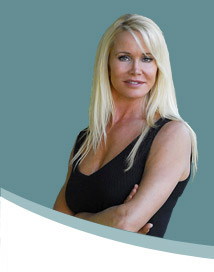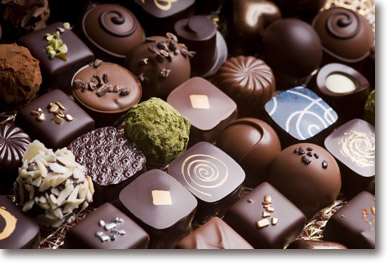


CHOCOLATE ARCHIVES
K Chocolatier
Bulletproof Chocolate Bars
Valerie Confections
Pumpkin Spice Salted Caramels
Lover Raw Chocolate
Mignon Chocolate
Santosha Chocolate
Chocolate Maya
Fearless Chocolate
Chocolate Conspiracy
Stafford's Chocolates
Blanxart
Madécasse Madagascar Chocolate
Pure Madness Chocolate
Jer's Chocolates
Brix Chocolate
Eclipse Chocolate
Lady Chocolatt Café
Moonstruck
Cocoa Canyon
Amara Chocolate and Coffee
Mama Ganache
Vital Choice Chocolate
Recchiuti Confections
Trader Joe's
Wei of Chocolate
COCOVA
Vosges
Theo
Rori's Artisinal Creamery
Simón Coll
Chocopologie
Francois Payard
Kallari
Woodhouse
Cadeaux
Maison du Chocolat
Villars
Royce Nama
Valhrona
Early Beck
Chocolate Life

If you believe that the four major food groups are milk chocolate, dark chocolate, white chocolate, and chocolate truffle, you’re in a bit of trouble. But you're meant to live a chocolate life, you say. So how can you be expected to live without it? You can't. Admit it. Some things you just have to accept. But you do need to exercise a little damage control.
Believe it or not, chocolate can be good for you. No, this is not a fantasy website. It actually can be good for you-under the right circumstances.
Each month we will feature a new type of chocolate that will tempt you but “legally allow” you to indulge in a square or two.
The article below appeared in a recent issue of Spiritual Wealth by Alexander Green www.spiritualwealth.com and is reprinted with his permission. It is spot on in terms of explaining the when, why and how chocolate can be good for you.
WHAT WOMEN REALLY WANT
Sigmund Freud is considered one of the great thinkers of the early twentieth century.
He discovered the unconscious mind, treated mental disorders, interpreted dreams, pioneered psychoanalysis, and did important neurological research into cerebral palsy.
Yet late in life he still confessed, "The great question that has never been answered, and which I have not yet been able to answer, despite my thirty years of research into the feminine soul, is "What does a woman want?"
Hapless men have speculated on this subject for millennia. Occasionally, we think we've stumbled on the answer. Women want love, affection, honesty, beauty, commitment, kindness, security, empathy, appreciation.
At least, most of them do. Yet this is still the wrong answer. What women truly want - watch them nod their heads in agreement - is chocolate.
Ninety-nine percent of women polled say they enjoy it. (The other one percent, apparently, can't be trusted.) Men don't exactly turn up their noses at the stuff either.
Chocolate is a $60 billion global industry today. The average American consumes 12 pounds of chocolate per year. (58 million pounds are sold around Valentine's Day alone.) And the Swiss, Austrians, Germans, Irish, British, Norwegians, Danes, Belgians, Swedes and Australians all eat more than we do.
The confection has a long and storied history. Mesoamericans first cultivated cacao beans more than three thousand years ago. The Mayans made it into a sacred drink, offered it in tribute to kings, and placed it in the tombs of the nobility so they could savor it in the afterlife.
Common folk enjoyed it, too. Five hundred years ago, Spanish historian Oviedo y Valdes wrote, "It is the habit among Central American Indians to rub each other all over with pulpy cocoa mass and then nibble at each other."
(No word about the resulting population explosion.)
By the time Columbus arrived, cacao beans were the coin of the realm. And it wasn't long before Europeans back home were clamoring for it.
Today the world produces over three million tons of cacao beans a year. But the crop - called "the elixir of the gods" by Swedish botanist Carolus Linnaeus and (ahem) my wife - is demanding. It requires a long rainy season and deep rich soil within twenty degrees of the equator. And - like many of its advocates - cacao can be fickle. It requires high humidity, constant pruning, and protection against pests.
But it's worth it. And not just for the flavor. It turns out that, chemically-speaking, chocolate is a near-perfect food.
A 2006 John Hopkins study showed that eating a little bit every day is good for your health. Cacao helps the body process nitric oxide, a compound for healthy blood flow and blood pressure. It contains antibacterial agents that fight tooth decay. The cocoa butter in chocolate contains oleic acid, a mono-unsaturated fat that raises good cholesterol. Chocolate also contains phenyl ethylamine (a mild mood elevator) and flavanoids that keep blood vessels elastic.
Studies show that eating a little bit of chocolate once a week can reduce your risk of stroke by 25 to 45 percent.
Milk chocolate, however, is high in calories, saturated fat and sugar. If you're eating it solely for health reasons - and whom are you kidding? - stick with dark chocolate. It contains more cacao and less sugar.
Cacao is a storehouse of natural minerals. It's a source of copper in our diet and an antioxidant on the order of green tea, protecting against heart disease and helping alleviate stress. Dark chocolate is rich in polyphenols, as is red wine. Chocolate can provide an energy boost, too. It is an easy way to fuel up before, and during, intense activity.
Plus, there are psychological benefits. Chocolate increases serotonin production and releases endorphins. It contains phenylethylamine, the same chemical that is released in the brain when we fall in love. Eating chocolate gives many women a natural "high," a feel of ecstasy.
Some researches even believe chocolate slows the aging process. (It probably doesn't but what have you got to lose?)
We shouldn't take these health claims too far, of course. Physicians rarely say "take a candy bar and call me in the morning." There is no such thing as prescription-strength chocolate.
But perceptions are changing. When I was a kid, conventional wisdom was that chocolate made you fat, gave you pimples and ruined your teeth. Modern science is tempering this view.
And the rewards aren't just physical. There's also the aesthetic. Chocolate is the final touch of elegance at the end of a good meal - or a special treat to be savored.
Even in tough times like these, chocolate is a luxury you can afford. Pastry chef Norman Love points out that "You can buy two bars of the best chocolate in the world for $5. The Queen of England can't buy any better chocolate than you can."
Premium chocolate is only slightly less nuanced than fine wine. It's recognized by its aroma, strength, and balance of taste sensations and interesting textures. It is a reminder to slow down, look, smell, taste, and take your time. Be grateful, one French gourmet says, "for what God and two thousand years of civilization have allowed to land on your tongue."
Chocolate is something we all associate with the best part of childhood. It provides a feeling of wellbeing. It has clear health benefits. It doesn't just taste good. It helps you live longer. No wonder women find it only slightly less vital than oxygen.
So, instead of flowers or champagne, next time try bringing home a three-and-a-half-ounce bar of Ghirardelli Intense Dark Twilight Delight. And then step back. You don't ever want to stand between a woman and her chocolate.
That sort of thing never ends well.
Carpe diem